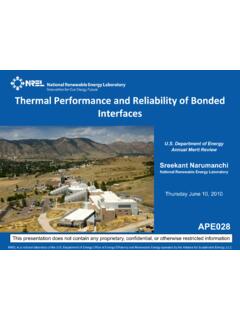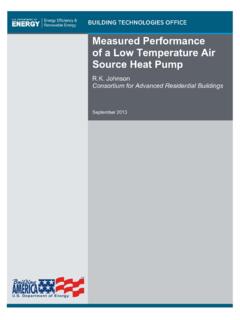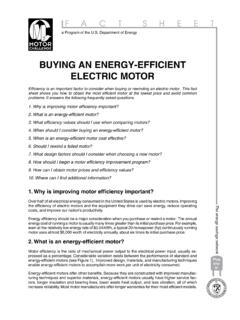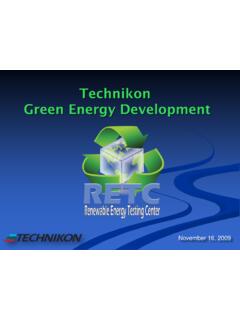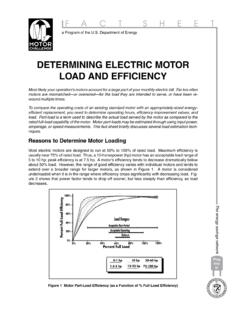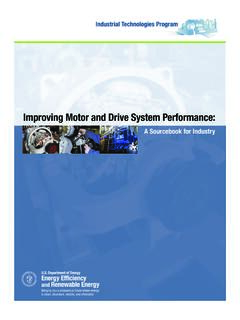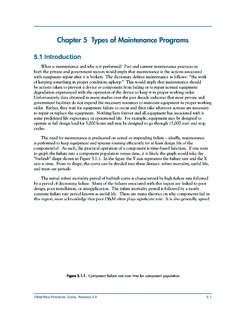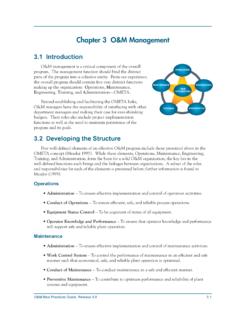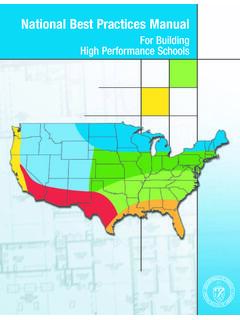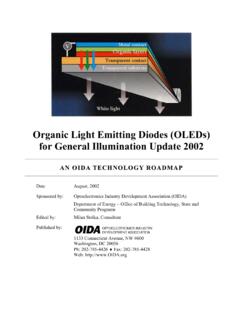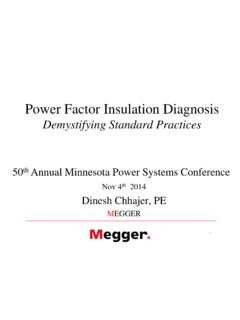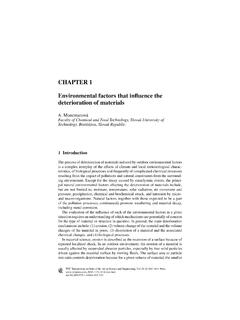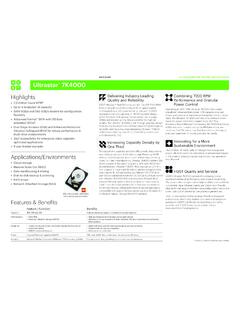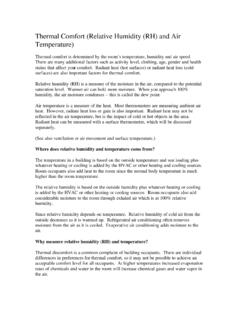Transcription of Calculating Light Loss Factors - Energy
1 SOLID-STATE STREET LIGHTINGCALCULATING Light LOSS FACTORSCONTACT INFORMATION:Dana BeckwithSenior Transportation Engineer1400 SW 5thAvenuePortland, Oregon 97201 Phone: Why Use Light Loss Factors Standards Lamp Life Light Loss Factors Equipment Factors Maintenance Factors Luminaire Dirt Depreciation (LDD) Lamp Lumen Depreciation (LLD) L70 LALWHY WE USE Light LOSS Factors (LLF) Luminaires age over time resulting in reduced lumen output Recognized standards identify minimum Light level requirements to be maintained on roadways and areas for life of lighting system. IESNA RP-8-00 AASHTO LLF allows the forecasting of system performance over a given lifetime to meet the minimum lighting standards Can help minimize liability system has been planned and designed for future operation, not just for the day it is and Area Lighting GoalSecurity, Safety, Commercial Interests, Community PrideSTANDARDS IESNA LM-79-08: IESNA Approved Method for the Electrical and Photometric Measurements of Solid-State Lighting IESNA LM-80-08: IESNA Approved Method for Measuring Lumen Maintenance of LED Lighting Sources IESNA TM-21-11.
2 Projecting Long Term Lumen Maintenance of LED Light Sources4 IESNA LM-79-085 IESNA LM-80-086 RATED LAMP LIFEHID Sources Time in hours at which 50% of a large sample group of initially installed lamps failNote:Incandescent and fluorescent lamps are rated the sameLED Sources Lp= time in hours to which the lumen output has degraded to a percent p of initial lumens L70commonly used Use LM-80 report to help determine LpNote: LED lamps do not typically catastrophically fail. There lumen output degrades over time. This can be maintained through drive current LOSS Factors (SOLID STATE LIGHTING)LLF = LLD x LDD x ATF x HE x VE x BF x CDLLD: Lamp Lumen Depreciation LDD: Luminaire Dirt Depreciation ATF: ambient Temperature EffectsHE: Heat ExtractionVE: Voltage EffectsBF: Driver and Lamp FactorsCD.
3 Component Depreciation8 Maintenance FactorsEquipment FactorsLIGHT LOSS EQUIPMENT Factors LLF = LLD xLDD x AT Fx HEx VE x BF x CDAmbient Temperature Effects utilizes historic ambient temperature data for area and luminaire performance data from the manufacturer Based on on/off control, max/min operation temperatures , incident sunshine on luminaire and daytime heat effects. Work with Extraction luminaire has a thermal capacitance based on mass, specific heat of materials, and rate of dissipation. If system changes over time, it s thermal performance should be with LOSS EQUIPMENT Factors LLF = LLD xLDD x AT F x HE x VEx BFx CDVoltage Effects Most systems operate between 120 and 277 VAC.
4 Efficiencies can vary with changes in input voltages. Evaluate system for sensitive to these variations, voltage dips, or power line transients. Work with and Lamp Factors Some drivers provide AC and some DC current to LED. Drivers can be dimmable (continuous or step). Efficiency of the driver is reduced when LED load decreases. Evaluate if power supply output varies with operating temperature, current type and driver loading with Depreciation Components can be affected by heat and environmental aging. Optical systems are effected by UV and reflective surfaces by humidity and oxidation. Evaluate potential for aging and UV effects. Work with LOSS MAINTENANCE Factors LLF = LLD x LDDx ATF x HE x VE x BF x CDLuminaire Dirt Depreciation Dirt accumulates on the inside and outside of refractors, reflectors, and lamps, resulting in reduction of lumen output.
5 11 SOURCES FOR LDDDATA Historical site data Perform field measurements RP-8-05, Fig. 5 LDD curves based on ambient environmental conditions and exposure time (cleaning frequency)12 Light LOSS MAINTENANCE Factors LLF = LLDx LDD x AT F x HE x VE x BF x CDLamp Lumen Depreciation lumen output depreciates over time resulting in a gradual reduction in Light Maintenance is a function of Tjand Tawithin the LED LED s do not radiate heat Conduction and Convection are needed to keep LED s FOR LLDMEASUREMENTS Manufacturer test data these test should be done by independent laboratories. References include IESNA LM-79-08, LM-80-08, and LM-21-11. Reliable field test FOR Calculating LLD L70 life of system is based on luminaire retaining 70% of original lumen output Application Life (LAL) life of system is based on a chosen number of operating hours equal to or greater than the pay back period of the L70?
6 LM-80-08 lists a couple of examples, one indicates L70(hours) = time to 70% lumen maintenance. -OR -The Design Guide for Roadway Lighting Maintenance DG-4-03 indicates the best time schedule for relamping of HID luminaires is when the cost of installation, Energy use, andrelampingis minimal. This occurs at approximately 70% of rated lamp LIKELY BECAUSE OF THE FOLLOWING -1718 WHAT DOES L70 MEAN IN TIME Fixture replacement at approx. 148,000 hrs(34 years) Increase in system hardware for new installations Prohibitive use of LED s on upgrade to existing installations due to Light levels not able to be met Higher initial lumen output diminishing to designed level at 34 years19 WHAT DOES L70 MEAN IN DESIGN TOFROM Wasted Energy costs until end of life when design minimum Light levels are met.
7 Large change in lumen maintenance needs & higher capital costsLLDBASED ON APPLICATION LIFE (LAL) Life of system is based on a chosen number of operating hours equal to or greater than the pay back period of the luminaire. Payback determined by a cost/benefit analysis Lets make some basic assumptions to illustrate: 12 year luminaire life (50,000 hours) Retain L70as an absolute minimum Light level Maintenance will occur once during lifetime of fixture Failure rate of 10%20 Hold it, what about our payback period, can we achieve it?LED LUMINAIRE COST/BENEFITC urrently pay back is achievable within 2 to 6 years of installation when compared to existing HID installations of 100W HPS luminaires in residential areas at least in 8-5 Payback CalculatorDecriptionBase SystemLuminaire A2 Luminaire A2 Number of Luminaires111 Number of Lamps per Luminaire111 Cost per $ $ $ Installation $ $ $ Initial $ $ $ Annual Operations Cost per FixtureWatts per Fixture (luminaire and ballast/driver)142109109kW per Hours of Operation (12 hrs per day)
8 4,380 hrs4,380 hrs4,380 hrskW Hours per kWhElectric Rate ($/kWH) $ $ $ Annual Energy $ $ $ Annual Maintenance CostFixture Life (yrs)15 yrs15 yrs15 yrsLamp Life (hrs)*30,000 hrs50,000 hrs50,000 hrsLamp Life (yrs) yrsTheoretical Relamps/Cleanings Over Life of Relamps/Cleaning Over Life of per Relamp/Cleaning (maintenance + parts)** $ $ $ Annualized Relamp/Cleaning $ $ $ Other Annulized Costs (Catastrophic Failure/Damage)** $ $ $ Annual Maintenance $ $ $ Conservation RebatekWh Saved Compared to Base System** kWhAdjustments (Conservation Rebate $ ) $ $ Payback (Compared to Base HPS System)
9 Adjusted Initial Cost per $ $ $ Rebate AdjustedAnnual Operations $ $ $ Annual Operations $ $ Annual Maintenance $ $ $ Annual Maintenance $ $ Total Annual O&M $ $ Payback yrs* Curre nt Manuf acture r Cl ai ms f or l i f e of LED i s 50,000 hrs to 100,000 hrs. Low end of projected life used for comparison purposes.** LED fixtures to be cleaned only, no relamp required. **Assumes a 25% failure rate for HPS luminaires and theoretical 10% failure for LED fixtur**Savings shown as a positive Demand and SavingsWatts per Fixture142109109 Base in kWh (Compared to Base System) yrsTable 8-5 Payback CalculatorDecriptionBase SystemLuminaire A2 Luminaire A2 Number of Luminaires111 Number of Lamps per Luminaire111 Cost per $ $ $ Installation $ $ $ Initial $ $ $ Annual Operations Cost per FixtureWatts per Fixture (luminaire and ballast/driver)142109109kW per Hours of Operation (12 hrs per day)
10 4,380 hrs4,380 hrs4,380 hrskW Hours per kWhElectric Rate ($/kWH) $ $ $ Annual Energy $ $ $ Annual Maintenance CostFixture Life (yrs)15 yrs15 yrs15 yrsLamp Life (hrs)*30,000 hrs50,000 hrs50,000 hrsLamp Life (yrs) yrsTheoretical Relamps/Cleanings Over Life of Relamps/Cleaning Over Life of per Relamp/Cleaning (maintenance + parts)** $ $ $ Annualized Relamp/Cleaning $ $ $ Other Annulized Costs (Catastrophic Failure/Damage)** $ $ $ Annual Maintenance $ $ $ Conservation RebatekWh Saved Compared to Base System** kWhAdjustments (Conservation Rebate $ ) $ $ Payback (Compared to Base HPS System)
